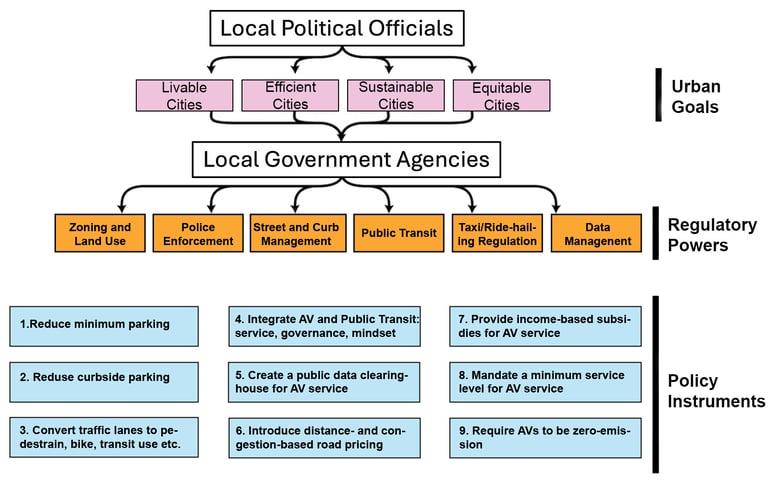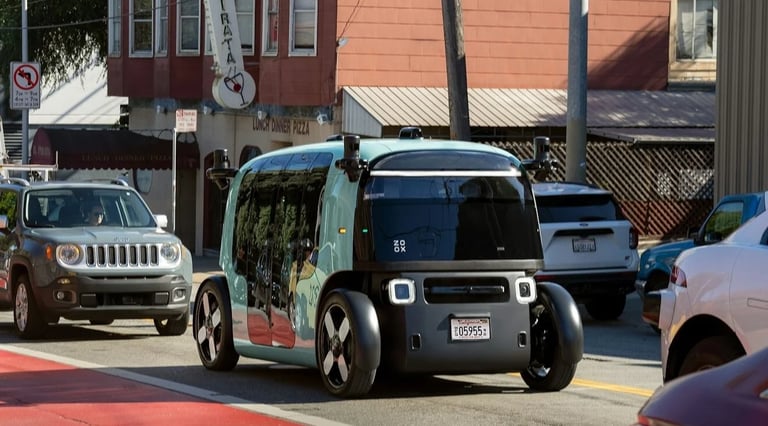Cities Are Not Prepared for Autonomous Vehicles. ---Here’s How Should They.
6/18/20254 min read
Autonomous vehicles are arriving, but cities aren’t ready.
Ten years ago, cities were energized by the promise of autonomous vehicles.
In 2015, the buzz was loud. Cities ran pilots, hosted workshops, and published white papers.
But the tech wasn’t ready. Cities grew disillusioned.
Now the tech is real—and scaling. But the cities? Most U.S. cities have no AV strategy, no designated leadership, and no plan to respond.
In 2019, we surveyed 120 U.S. municipalities with populations over 100,000 and reviewed 25 major city plans. Here is what we found:
🟡 64% of the 25 largest cities didn’t even mention AVs in their comprehensive or transportation plans.
🟡 81% of planning and transportation officials reported “little or no staff time yet committed to AVs.”
🟡 The prevailing stance? “Let’s wait and see what the feds or states decide.”
Why is this a problem?
Because AVs won’t wait for permission. They are already arriving—on city streets, at airports, in commercial zones. They're scaling rapidly, propelled by billions in private capital and real-world deployments in cities from San Francisco to Phoenix.
And with them come changes that strike at the core of city governance:
Transportation: AVs alter travel patterns, induce demand, and reshape modal choices—may undermine public transit.
Land Use: With reduced parking needs and new access demands, AVs offer more opportunity for densifying land use, better zoning, curb space management, and real estate investment.
Data Governance: AVs generate high-resolution mobility data, but most cities have no standards for access, privacy, or accountability.
Labor: They impact local driving jobs—while creating many new ones—without any city-led plan for economic transition or support.
When cities have no AV strategy, no clear leadership, and no regulatory plan, they surrender the future by default.
“Wait and see” is no longer a neutral stance. It’s a choice with consequences.
How can cities lead boldly and plan wisely?
I suggest a three-step roadmap:
Step 1: Rethink AVs as political leverage—not just a tech shift, but a policy unlock. Let's flips the script: AVs are not just a regulatory challenge. They can be a political opening. AVs can make long-stuck policies—like pricing streets or reducing parking mandates—more feasible.
Step 2: Identify internal actions—what city leaders can do now with the powers they already hold. I propose a three-part framework: Define the public interest (goals); Determine local authority (power); Design AV policy (instruments)
Step 3: Define external strategies—how to engage industry and prepare the public. Cities need to turn outward: engage the AV industry proactively—setting expectations, not just reacting. And they must prepare the public—building trust, communicating trade-offs, and ensuring all residents understand what’s at stake.
Autonomous vehicles won’t wait for cities to catch up. Cities still have the chance—and the tools—to lead.
Step 1: Rethink AVs as political leverage
AVs didn’t just change technology. They changed the politics.
In 2019, We interviewed 25 municipal transportation and planning officials, comparing their views on political feasibility “today” vs. “in a future with widespread AV deployment.” The gaps were striking:
1️⃣ Congestion and distance-based pricing: +45 points
2️⃣ Trip data clearinghouses for transparency: +45 points
3️⃣ Removing minimum parking mandates: +70 points
Same cities. Same policies. But with AVs in the picture, the politics shift.
Why? Because AVs give officials something powerful:
🗞️ A new narrative
🌅 A fresh start
🚀 A reason to act
When AVs arrive, formerly “impossible” policies feel logical, manageable—even necessary.
But not everything gets easier. Equity-focused reforms remain politically hard—even in a high-tech future.
The takeaway: AVs won’t fix our cities. But they give us the excuse we need to try.
They offer political cover and administrative leverage to advance bold, long-debated reforms. Yet they also reveal where resistance remains, with or without new technology.
Step 2: Identify internal actions
Municipalities have more leverage than they often realize. They are not passive recipients of AV innovation—they are essential architects of its future.
Here’s what cities can do:
1️⃣ Define the public interest
2️⃣ Determine regulatory authority
3️⃣ Design policy instruments
Let’s unpack each.
1. Define public interest
While the 25 largest U.S. cities broadly agree on values in their transportation plans, they differ in emphasis:
✔️ Livability: 100%
✔️ Efficiency: 92%
✔️ Environment: 88%
✔️ Equity: 52%
Most cities frame AVs as tools for “innovation” rather than for city-building—missing a chance to align AVs with holistic urban goals.
2. Determine regulatory authority
Federal and state agencies set the technical AV standards on safety and emission, but cities shape how AVs show up in urban streets. Cities retain significant control over how AVs operate locally. This includes:
Street and curb management
Zoning and Land Use
Police enforcement
Public transit
Taxi/Ride-hailing Regulation
Data Management
3. Design policy instruments
There are 9 AV-related policies in three themes that cities can deploy today:
Land Use & Road Design
1. Reduce minimum parking requirements for new developments
2. Reduce curbside parking
3. Convert traffic lanes to pedestrian, bike, or transit use
Integration with Transit, Data, Congestion Pricing
4. Integrate AV and Public Transit: service, governance, mindset
5. Create a public data clearinghouse for AV service
6. Introduce distance- and congestion-based road pricing
Equity & Environment
7. Provide income-based subsidies for AV service
8. Mandate a minimum service level for AV service across the city
9. Require AVs to be zero-emission
Cities can connect the (urban) goals, the (regulatory) power, and the (policy) instruments.
3 Part Action Framework
Step 3: Define external strategies to engage industry and prepare the public.
👉🏻 Engage industry proactively – Set expectations, co-design systems
AV operators are moving fast—deploying fleets and shaping norms. Instead of waiting for conflict, municipalities should engage with industry early—on their own terms.
Cities should work with the industry to:
Set expectations—on data-sharing, curb use, integration with transit, and equity goals.
Co-design public benefit—as seen in Stockholm’s contracting model or Singapore’s transit-first strategy
The public sector not just regulates, it can enable the new technology, and co-create the mobility system.
👉🏻 Prepare the public – Build trust, inform choices, manage expectations
AVs will challenge the way residents move—and the norms and habits they hold.
If cities don’t explain what’s changing and why, there may be backlash from the public.
Cities need a communication strategy as deliberate as their technical one:
Explain what’s changing—and why it matters: jobs, congestion, safety, data
Engage early and inclusively—especially with communities often left behind
Surface trade-offs—cheaper trips might mean more traffic; automation might reduce crashes but affect employment.
AVs can serve the public—but only if the public is brought along.
Cities can lead with clarity of purpose, authority of action, and consent of the governed.




Interested to receive practical insights, actionable frameworks on mobility and city policies backed by research?
Contacts
jinhua@jzresearch.org